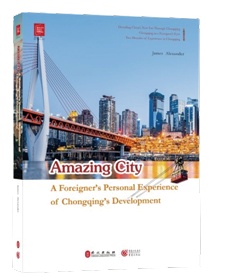
Amazing City: A Foreigner’s Personal Experience of Chongqing’s Development
Author: James Alexander
Paperback, 308 pages
Published by Foreign Languages Press
James Alexander, a British columnist with the Western China International Communication Center, has been living in southwest China’s Chongqing for more than 20 years.
Over the past two decades, he has developed from a single, adventurous young writer into a husband, father of two girls, and a professional with multiple accomplishments. Alexander has visited many impoverished areas in Chongqing, experienced the local intangible cultural heritage, learned about the ancient wisdom behind traditional Chinese medicine, and tried his hand at embroidery and playing folk music.
In this book, he tries to introduce Chongqing from six different angles: its expansion from a southwest backwater to internationally renowned sprawling municipality, infrastructure that has transformed it into an international transport hub, technology boom, environmental improvement, rural revitalization, and cultural renaissance.
In the first chapter, he leads readers on a tour around Chongqing, which is commonly known as a “Fog City” due to its unique blend of topographical and manmade factors. In Chongqing, there are many large roughly parallel ridges that stretch for hundreds of miles, with huge urban areas developed among the lush plains in between, and sleepy towns and villages nestled discreetly on the hillsides and mountain plateaus. These geographical conditions, matched with a humid climate, mean that fog regularly descends on the city, and thick blankets of clouds means it receives the least sunshine hours anywhere in China.
The major escalation of urban expansion has taken place in Chongqing over the past two decades, with large engineering projects opening up vast new swathes of land just ripe for development. For example, historical photographs show that the 27.5-meter-tall Liberation Monument towered well above the surrounding architecture. Today, the monument is dwarfed on all sides by skyscrapers, among which the Chongqing World Financial Center stands tallest at a neck-contorting height of 339 meters.
In the second chapter, Alexander introduces how this hinterland transformed into an international transport hub. The mountainous topography of Chongqing long dictated that most inner-city roads were narrow, windy, and difficult to maintain. Chongqing therefore implemented a wave of bridge construction, which opened up new development possibilities, greatly alleviating the pressure on river crossings. These infrastructure projects were completed at such a rapid rate that Chongqing earned the prestigious title of “Bridge capital of China.”
Now, Chongqing possesses excellent geographical and logistical advantages, placed at a key junction between Europe and Asia, and the developing Chengdu-Chongqing Economic Circle is set to rival the coastal powerhouses of the Beijing-Tianjin-Hebei region and the Yangtze and Pearl River Deltas in the very near future.
The third chapter highlights the technology boom in Chongqing, unveiling how its labor- intensive economy has made way for that of hi-tech. Technology parks and manufacturing bases around Chongqing have introduced an impressive array of semi-automated production lines. In a factory that produces smart door locks, robots busily perform repetitive assembly tasks and the long process of durability testing, while human workers assure the machines have the proper resources available, and perform overall quality control at key junctures and on completion. A favorable business environment has also spurred the creation of innumerable start-ups that have achieved impressive growth in just a few years.
The fourth chapter focuses on the city’s green development. Along with bluer skies and cleaner waterways, the green actions have helped create a safer and more pleasant living environment for millions of local residents, while also clearing land for new developments such as modern apartment blocks and commercial quarters. It is interesting to see how the renovation approach has transformed abandoned factory sites into tourist attractions and a popular base for enterprising business innovators.
In addition, Chongqing has seen a great increase in the number of days with good air quality, which has improved the natural environment for migratory birds of prey, another example of how ecological restoration has contributed to biodiversity.
The fifth chapter tells the story of rural revitalization, which enables rural communities to take prosperity into their own hands. As a response to the battle against poverty, Chongqing set its own ambitious plan to resolve the predicament faced by more than 1.66 million people in its rural areas.
The last chapter is the author’s observations of the cultural side of Chongqing, believing that the intangible cultural heritage has undergone an impressive renaissance. Counties and districts in Chongqing all possess their unique and rich varieties of culture, which have thrived for centuries but are facing challenges, particular to their native environment and from outside influences. Now, thanks to the dedication of passionate inheritors, and support conferred by official recognition as intangible cultural heritage, the advent of social media has offered a lifeline where the precious tradition can reach millions of viewers.
The author concludes his book by saying that his journey of discovering Chongqing has barely reached a halfway point, and the fascinating prospects of the city he calls home will hopefully bring a whole new world of surprises as the future unfolds.